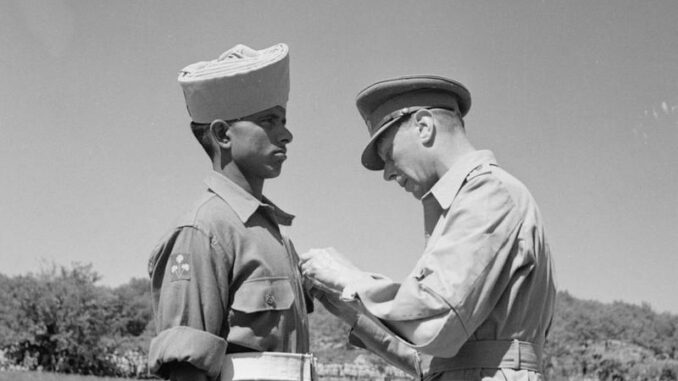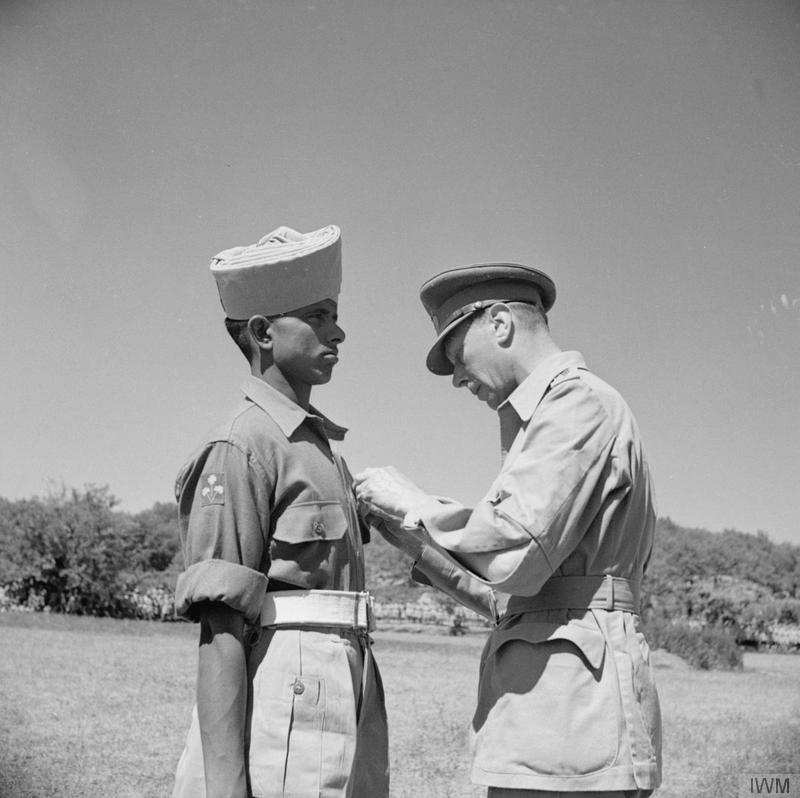

Indice dei contenuti
Victoria Crosses in Cassino Area: we must Remember them
The Victoria Cross is the British realm’s highest award for gallantry in the face of the enemy.
The Vistoria Cross was founded by Royal Warrant on 29 January 1856 to awaerd those who fight during the Crimean War and is still today handmade by Hancocks and Company (Jewellers) of London . The Cross itself is cast from the bronze of Russian cannons captured at Savastopol during the War. The design, chosen by Queen Victoria, consists of a Maltese cross with the Royal Crest resting upon a scroll bearing the words ‘For Valour’, while on the reverse of the medall is writen the name of the recipient.
Victoria Crosses in Cassino Area
Since its inception the Victoria Cross has been awared 1354 soldiers. The youngest recipient was 15 years old and the eldest was 69 years old. Three cases exist where both father and son have won the Victoria Cross: four pairs of brothers have also been recipients
Twenty members of the British and Commonwealth forces were awarded the Victoria Cross for bravery in the Italian Campaign. Five of these were awarded in the attempts in the battles for Monte Cassino and the attemps to force the Gustav Line.
George Allan Mitchell and his Victoria Cross
- George Allan Mitchell (The London Scottish (Gordon Highlanders) British Army)
In Italy on the night of 23rd and 24th January 1944, a Company of the London Scottish was ordered to carry out a local attack to restore the situation on a portion of the main Damiano ridge. The Company attacked with two platoons forward and a composite platoon of London Scottish and Royal Berkshires in reserve. The Company Commander was wounded in the very early stages of the attack. The only other officer with the Company was wounded soon afterwards.
What he did
A section of this Company was ordered by the Platoon Commander to carry out a right flanking movement against some enemy machine guns which were holding up the advance. Almost as soon as he had issued the order, he was killed. There was no Platoon Sergeant. The section itself consisted of a Lance Corporal and three men, who were shortly joined by Private Mitchell, the 2-inch mortarmen from Platoon Headquarters and another private. During the advance, the enemy opened heavy machine gun fire at point blank range. Without hesitation, Private Mitchell dropped the 2-inch mortar which he was carrying, and seizing a rifle and bayonet, charged, alone, up the hill through intense spandau fire.
The Medal
He reached the enemy machine gun unscathed, jumped into the weapon pit, shot one and bayonetted the other member of the crew, thus silencing the gun. As a result, the advance of the platoon continued, but shortly afterwards the leading section was again held up by the fire of approximately two German sections who were strongly entrenched. Private Mitchell, realising that prompt action was essential, rushed forward into the assault firing his rifle from his hip, completely oblivious of the bullets which were sweeping the area.
The Victoria Cross
The remainder of his section followed him and arrived in time to complete the capture of the position in which six Germans were killed and twelve made prisoner. As the section was reorganising, another enemy machine gun opened up on it at close range. Once more Private Mitchell rushed forward alone and with his rifle and bayonet killed the crew. The section now found itself immediately below the crest of the hill from which heavy small arms fire was being directed and grenades were being thrown. Private Mitchell’s ammunition was exhausted, but in spite of this he called on the men for one further effort and again led the assault up the steep and rocky hillside.
The importance of his bravery
Dashing to the front, he was again the first man to reach the enemy position and was mainly instrumental in forcing the remainder of the enemy to surrender. A few minutes later, a German who had surrendered, picked up a rifle and shot Private Mitchell through the head.
Burried at Minturno War Memorial
(if you want to know more about him and what happened please have a look here)
Fusilier Francis Arthur Jefferson
- Fusilier Francis Arthur Jefferson {The Lancashire Fusiliers}
On 16 May 1944 during an attack on the Gustav Line, the leading company of Fusilier Jefferson’s battalion had to dig in without protection. The enemy counter-attack opening fire at short range, and Fusilier Jefferson, on his own initiative, seized a PIAT gun and, running forward under a hail of bullets, fired on the leading tank. It burst into flames and all the crew were killed. The fusilier then reloaded and went towards the second tank which withdrew before he could get within range. By this time our own tanks had arrived and the enemy counter-attack was smashed. please have a look here)
Lieutenant Richard Wakeford
- Lieutenant Richard Wakeford {The Hempshire Regiment}
On 13 May 1944 near Cassino, Captain Wakeford, accompanied only by his orderly and armed with a revolver went forward and killed several of the enemy and took 20 prisoners. When attacking a hill feature the following day his company came under heavy fire, but although wounded in the face and both arms, Captain Wakeford pressed home the attack. Hewas wounded again, but reached the objective and consolidated the position.
(If you want to know more about him and what happened please have a look here)
Major John Keefer Mahony
- Major John Keefer Mahony { the Westminster Regiment, Canadian Army}
On 24 May 1944 at the River Melfa Major Mahony and his company were ordered to establish the initian bridgehead over the river. This was accomplished and for five hours the company maintained its position in the face of enemy fire and attack until the remaining companies and supporting weapons were able to reinforce them. Early in the action Major Mahony was wounded in the head and twice in the leg, but herefused medical aid and continued to direct the defence of the bridgehead. The enemy saw that this officer was the soul of the defence and consequently made him their particular target.
(If you want to know more about him and what happened please have a look here)
Sepoy Kamal Ram
- Sepoy Kamal Ram { ottoth Punjab Regiment, Indian Army}
On 12 May 1944 at the River Garigliano, the company advance was held up by heavy machine-gun fire from four posts on the front and flaks. The capture of the position was essential and Sepoy Kamal Ram volunteered to get round the rear of the right post and silence it. He attacked the first two posts single-handed, killing or taking prisoner the occupants and together with a havildar he then went on and completed the destruction of a third. His outstanding bravery unquestionably saved a difficult situation at a critical period of the battle.
(If you want to know more about him and what happened please have a look here)
From ‘Second World War 60th Anniversary The Battles for Monte Cassino‘
